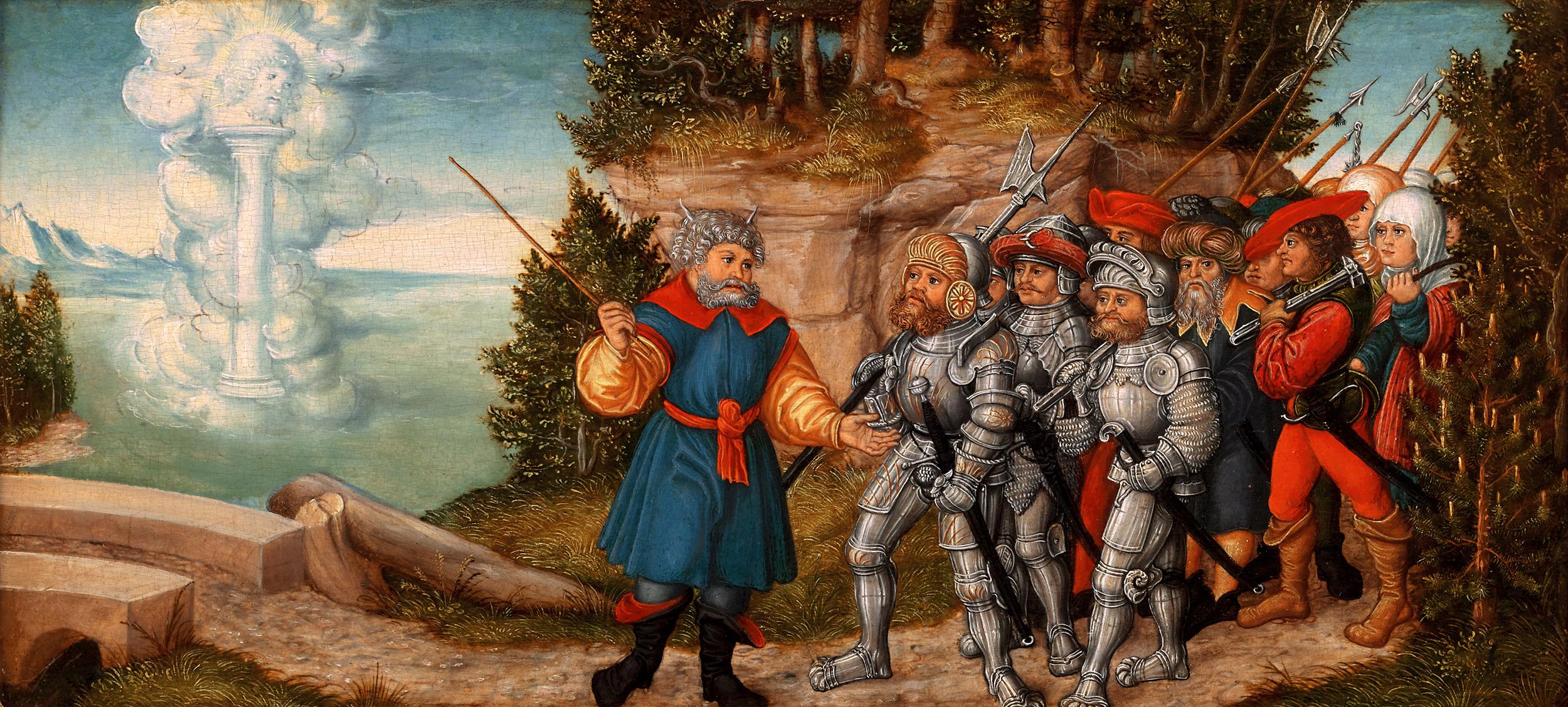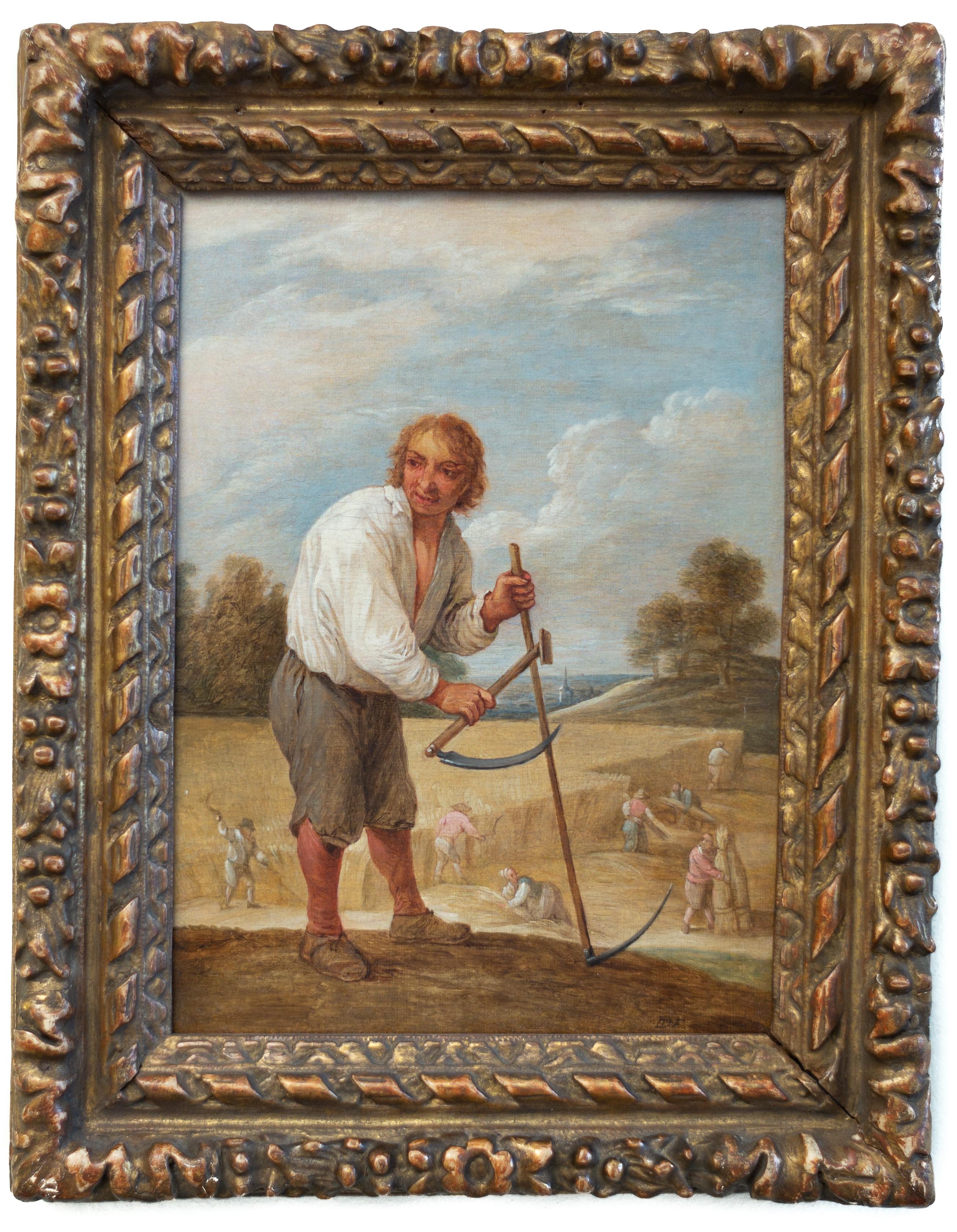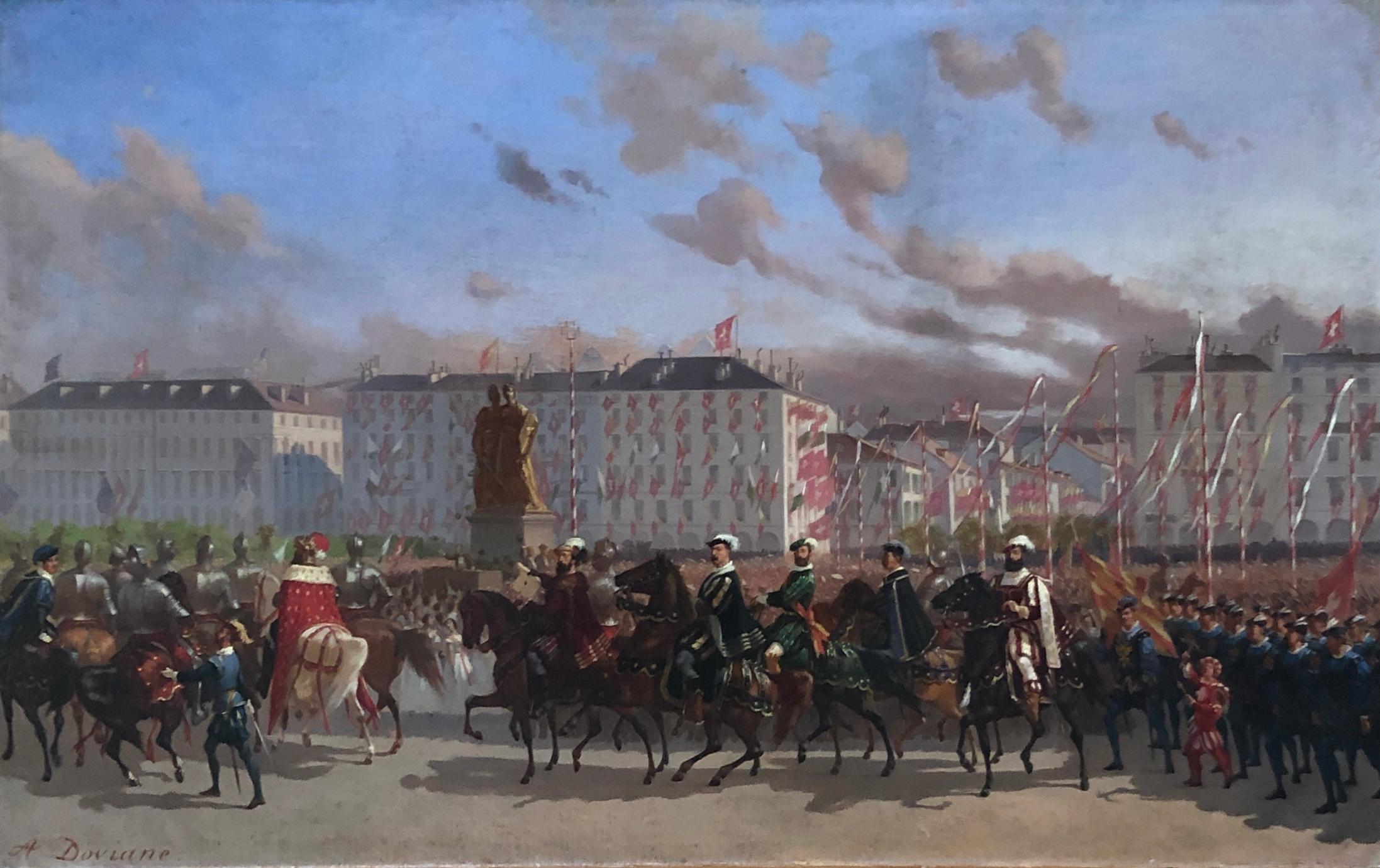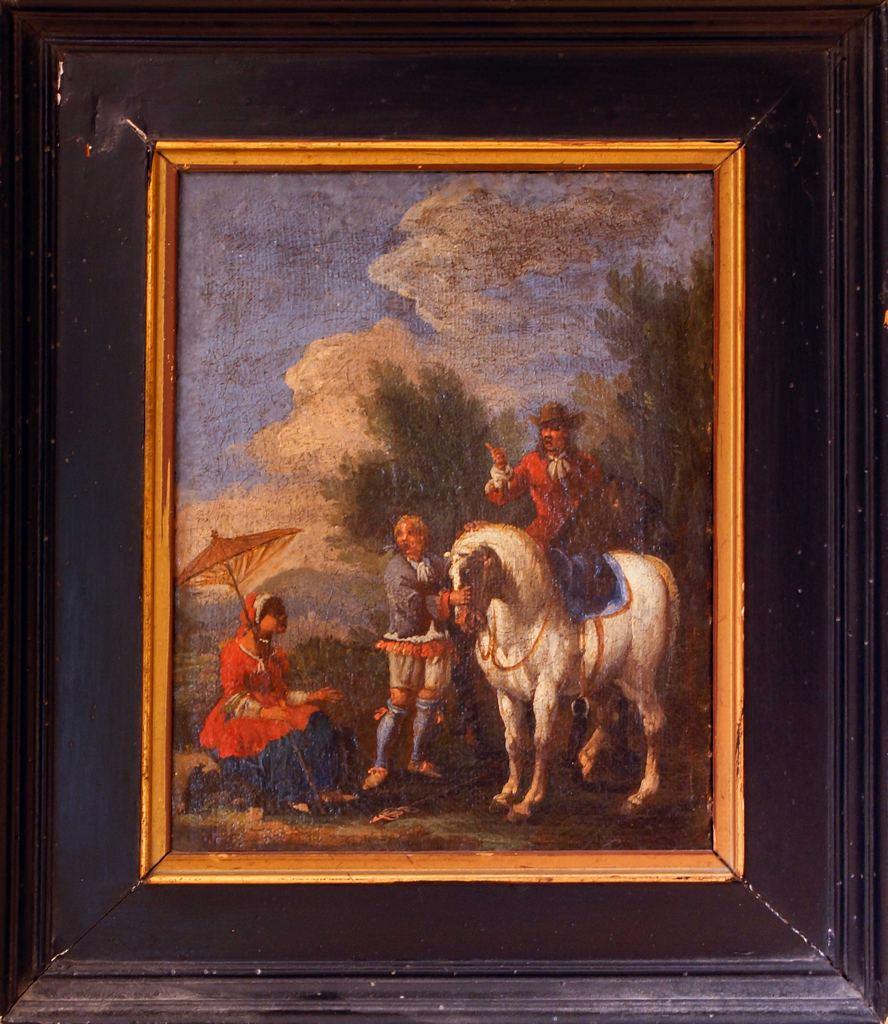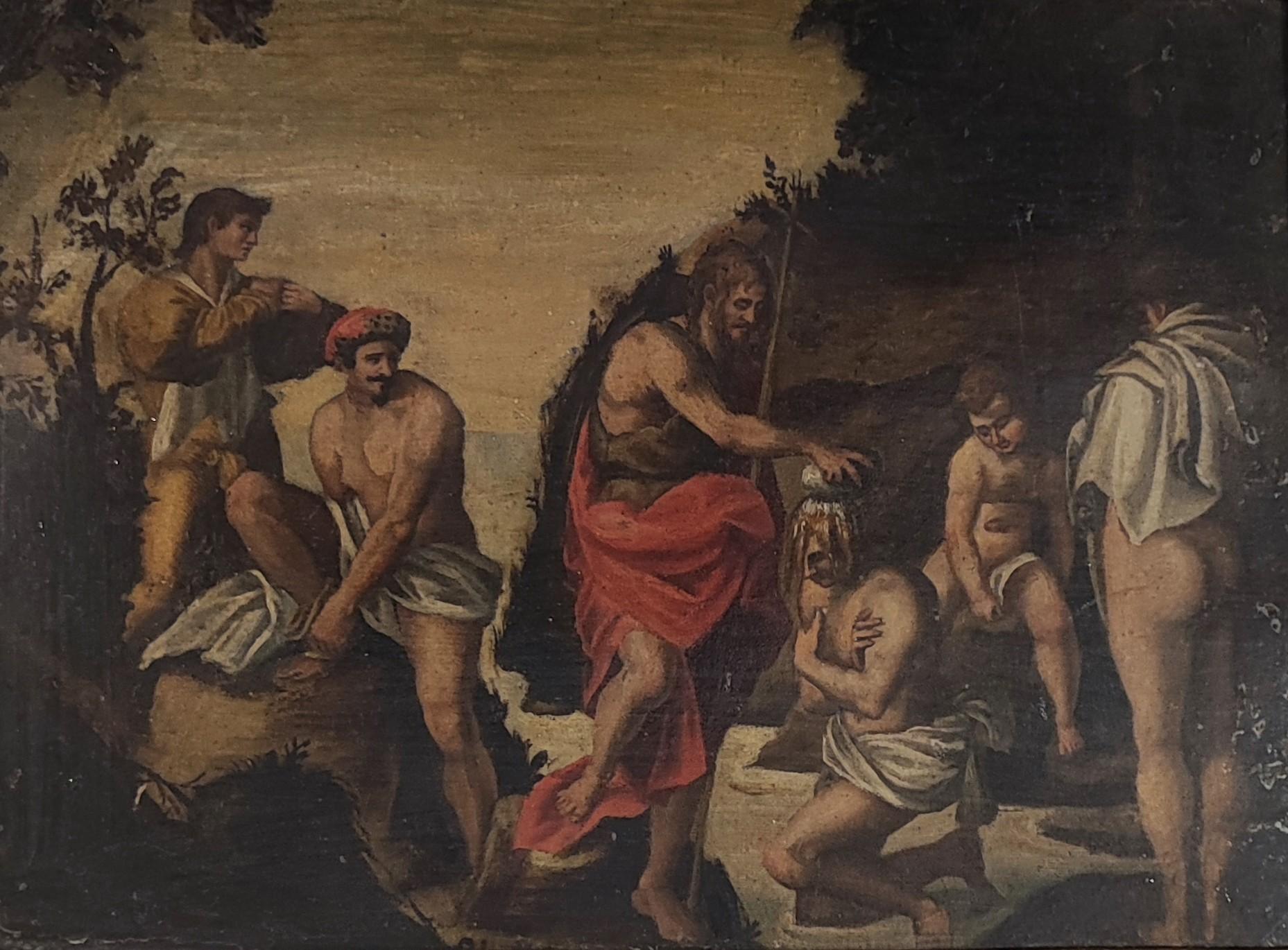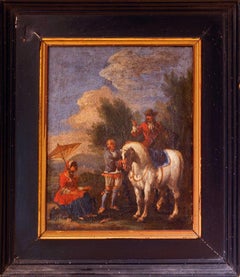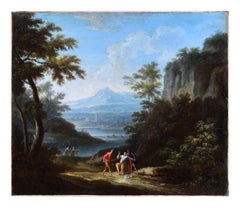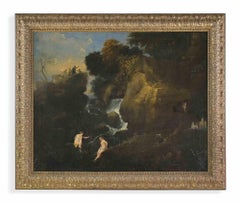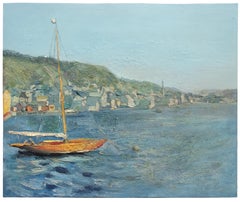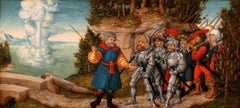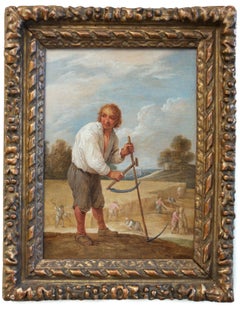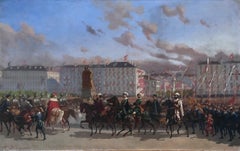Items Similar to Martyrdom of Saint Stephen- Painting attr. to Vincent Adriaenssen- 17th Century
Want more images or videos?
Request additional images or videos from the seller
1 of 8
Martyrdom of Saint Stephen- Painting attr. to Vincent Adriaenssen- 17th Century17th Century
17th Century
About the Item
Landscape with martyrdom of Saint Stephen is an old master artwork realized in 17th century.
Mixed colored oil painting on canvas.
Includes coeval gilded frame cm. 148x196.
The artwork is attributed to Vincent Adriaenssen called il Manciola (Antwerp, 1595 - Roma, 1675)
Among the painters who worked in the first half of the seventeenth century it is possible to indicate only the Neapolitan Scipione Compagno (1624-1680) as the author of scenes of martyrs set within a landscape or a view such as, for example, the Martyrdom of Saint Stefano recently hesitated at the Ansorena in Madrid on June 16, 2021. It should be noted, however, that the landscape represented in the painting examined here, characterized by luxuriant vegetation, meticulously represented "in the Flemish style", shows differences with the typical settings of the paintings di Compagno, characterized above all by urban views, visionary architectures or rather arid vegetation. Even the refined figures, so elongated and lanky, represented in our painting, in particular the group of knights in the foreground on the right, are not reflected in the production of the Neapolitan painter. These elements, to which we add the depiction of the Eternal Father amidst the clouds and the detail of the dog in profile in the foreground, instead recall a painter mainly known as a battle soldier, but who was also the author of many works depicting episodes from ancient Rome set within luxuriant landscapes, or rather Vincent Adriaenssen known as Manciola, a painter from Antwerp whose figure has been shed light thanks to recent studies. The group of horsemen represented to the right of the examined painting is, in fact, comparable with other groups on horseback present in numerous works by Manciola such as, for example, in the Triumph of Caesar (Rome, Babuino, 23-03-2010; formerly Florence, Collection Privata, 2006), while similar elongated and somewhat lanky figures, dressed in red, yellow, blue and white, can be found in the three paintings conserved at the Cassa di Risparmio di Pesaro, which in the past were erroneously attributed to the Umbrian painter Francesco Allegrini (1587-1663). Adriaensz, called Manciola because, lacking his right hand, he painted with his left, was a pupil of Pieter Paul Rubens (1577-1640) and his activity took place between Rome (from 1625 to 1645; from 1661 to 1675) and Paris (between 1640 and 1641; from 1645 to 1661) where, on the recommendation of Nicola Poussin, he worked for Chantelou and then for Cardinal Mazarin. Although there are few landscapes by Manciola that have come down to us with respect to the battles, in the ancient inventories there are, in reality, very numerous paintings representing landscapes that testify to a dispersed production of the Antwerp artist.
Reference bibliography:
- A. Marabottini, Two canvases by Vincent Adriaensz known as il Manciola and a late "errata corrige", in "Commentari d'arte", 12, 2006, pp. 41-50.
- C. de Aldecoa, Vincent Adriaenssen Leckerbetien dit il Manciola ou le Manchole Anvers, 1595 - Rome 1675: un peintre connu mais oublié, in “Bulletin de l'Association des Historiens de l'Art Italien”, 7. 2001, pp. 28-47.
- E.Fumagalli, A battalion found. Vincent Adriaenssen known as Manciola, in “Paragone”, 50, 1999, 28, pp.3-24.
- A.G. De Marchi, Manciola and more: notes on Battaglia's painting, in “Paragone”, 50, 1999, 28, pp.25-40.
- M.R.Nappi, The Neapolitan Philip by Roberto Longhi. Scipione Compagni or Cornelio Brusco, in Perspective, 47, 1986, pp. 24-37.
Expertise by Dr. P. Basso Bondini.
- Attributed to:Vincent Adriaenssen
- Creation Year:17th Century
- Dimensions:Height: 49.22 in (125 cm)Width: 68.9 in (175 cm)Depth: 0.04 in (1 mm)
- Medium:
- Movement & Style:
- Period:
- Framing:Framing Options Available
- Condition:Insurance may be requested by customers as additional service, contact us for more information.
- Gallery Location:Roma, IT
- Reference Number:Seller: T-1369611stDibs: LU650311615702
About the Seller
4.9
Platinum Seller
Premium sellers with a 4.7+ rating and 24-hour response times
1stDibs seller since 2017
7,512 sales on 1stDibs
Typical response time: 2 hours
- ShippingRetrieving quote...Shipping from: Grasse, France
- Return Policy
Authenticity Guarantee
In the unlikely event there’s an issue with an item’s authenticity, contact us within 1 year for a full refund. DetailsMoney-Back Guarantee
If your item is not as described, is damaged in transit, or does not arrive, contact us within 7 days for a full refund. Details24-Hour Cancellation
You have a 24-hour grace period in which to reconsider your purchase, with no questions asked.Vetted Professional Sellers
Our world-class sellers must adhere to strict standards for service and quality, maintaining the integrity of our listings.Price-Match Guarantee
If you find that a seller listed the same item for a lower price elsewhere, we’ll match it.Trusted Global Delivery
Our best-in-class carrier network provides specialized shipping options worldwide, including custom delivery.More From This Seller
View AllThe Knight - painting - XVII century
Located in Roma, IT
The Knight is an original oil painting on canvas realized during the XVII century by an anonymous artist.
Provenance: Pecci-Blunt collection. Good condition...
Category
17th Century Old Masters Figurative Paintings
Materials
Canvas, Oil
$3,597 Sale Price
30% Off
Two Arcadic Landscapes - J.F. Van Bloemen (follower of) - Oil on Canvas
By Jan Frans van Bloemen (Orizzonte)
Located in Roma, IT
Two Arcadic Landscapes are a couple of original oil paintings by a follower of the Flemish artist, Jan Frans Van Bloemen (1662-1749).
These old master's original paintings represen...
Category
Early 18th Century Old Masters Landscape Paintings
Materials
Oil
Landscape with Nudes and Waterfall - Oil Paint - 17th Century
Located in Roma, IT
Landscape with nudes and waterfall is an old master artwork realized in the Mid 17th century by Artist belonging to the Roman School.
Oil painting on canvas
Includes a beautiful an...
Category
Mid-20th Century Old Masters Figurative Paintings
Materials
Oil
Landscape - Oil Painting by Kurt Schwitters - 1936
By Kurt Schwitters
Located in Roma, IT
Landscape is a modern artwork realized by Kurt Schwitters in 1936.
Mixed colored oil on canvas.
Signed with monogram and dated on the lower right rec...
Category
1930s Modern Figurative Paintings
Materials
Oil
Pointilliste View of Istanbul - Painting by Stan Reszka - 1951
By Stan Reszka
Located in Roma, IT
Pointilliste View of Istanbul is a modern artwork realized by Stan Reszka in 1951
Oil on Canvas.
Hand signed Stan Reszka.
Titled, signed, dated on the reverse.
Includes frame.
S...
Category
1950s Modern Figurative Paintings
Materials
Paper, Oil
Landscape - Oil Paint by Giovanni Meroli - mid-20th Century
Located in Roma, IT
Landscape is a modern artwork realized in the mid-20th Century by Giovanni Meroli (1890-1960).
Mixed colored oil on canvas.
Hand signed on the lower margin.
Includes frame: 77 x 9...
Category
Late 20th Century Contemporary Landscape Paintings
Materials
Oil
You May Also Like
Bedouin at Prayer, Orientalist Oil Painting on Panel by Rudolf Ernst
By Rudolf Ernst
Located in Long Island City, NY
This painting by Orientalist artist Rudolf Ernst depicts a Muslim man in quiet contemplation during prayer. He kneels in solitude in the vast desert as the light fades around him. Ma...
Category
1890s Old Masters Figurative Paintings
Materials
Oil, Wood Panel
Moses and the Pillar of Cloud by Lucas Cranach the Elder and Studio
By Lucas Cranach the Elder
Located in New Orleans, LA
Lucas Cranach the Elder and Studio
1472-1553 German
Moses and the Pillar of Cloud
Oil on panel
Moses and the Pillar of Cloud is a bold and evocative composition that showcases the signature intense color and intricate detail of Lucas Cranach the Elder’s celebrated oeuvre. The remarkable 16th-century oil on panel by Lucas Cranach and his studio captures the narrative moment when Moses leads the Israelites out of Egypt and encounters God manifested through a large pillar of cloud. Moses stands at the precipice of a bridge and turns back to soldiers helping to lead the group of Israelites who huddle closely together. Cranach depicts Moses with his traditional iconography, rendering the rays of light on his head which came to be interpreted as "horns" in the translation of the Bible. Using his traditional walking staff, Moses gestures toward the pillar, seemingly acknowledging that God will protect the group as they cross the bridge to the other side, leaving exile and entering a promised land.
In a nod to Cranach’s Germanic locale, he renders the figures and setting in a manner that feels decisively more akin to European aesthetics than those of the Red Sea. Soldiers wear elaborate, gothic suits of armor that recall the livery of Northern European guardsmen. The terrain appears more like a European forest giving way to a sweeping valley than the arid landscape the Israelites trekked through on their journey across the Red Sea. Though still clearly recounting a story from the Old Testament, Cranach renders the cast of characters and setting in an earthly, familiar manner. This aesthetic shift speaks to Cranach’s own changing beliefs as he found himself at the center of the Protestant Reformation.
After first gaining recognition in 1505 as the official painter of Frederick the Wise, Cranach established a thriving painting and print studio in Wittenberg, Germany. Cranach was renowned for his court portraits and genre paintings and was also well known for his association with the famous protestant reformer Martin Luther, then under the protection of Frederick the Wise. As Wittenberg became a bastion of new religious thought, Cranach soon befriended Luther and played an active role in creating the printed materials that proliferated throughout the Reformation...
Category
16th Century Old Masters Figurative Paintings
Materials
Oil, Panel
Peasants in a Cornfield (Boer in het veld) by David Teniers the Younger
By David Teniers the Younger
Located in Stockholm, SE
Remembering the magic of everyday life moments in the art of David Teniers:
The art of David Teniers the Younger (1610–1690) coincided with the heyday of the Flemish Baroque and captured a great variety of motifs of his time. In this painting of a seemingly simple peasant scene lies keys to understanding both the imaginative mind of Teniers as well as why this time period produced some of the most iconic works in all of art history.
As indicated by the name, Teniers was more or less born into his profession. As the son of David Teniers the elder, himself a painter who studied under Rubens, the younger David received training in art from a very young age and had no less than three brothers who also became painters. Because of his father’s frequent financial failures that even at times saw him imprisoned, David the younger helped to rescue the family from ruin through painting copies of old masters. Essentially, the young Teniers was confronted with painting as both a passion and creative expression as well as a necessity during difficult times, an experience that would shape much of his capacity and sensitivity in his coming life.
Despite the hardships, the talent and determination of Teniers was recognized and quickly expanded his possibilities. He had already spent time in France and possibly also England when he was hired by his father’s former teacher Rubens to help with a prestigious commission with mythological paintings, now considered lost, for Philip IV the king Spain. In 1644–54 Teniers was appointed dean of the Antwerp Guild of Saint Luke, manifesting his esteemed position within the artistic community. A few years afterwards he took an important step when relocating to Brussels, where Teniers yet again found new career opportunities that would prove to be very successful.
As the keeper of the collections of Archduke Leopold Wilhelm, a role similar to what we now refer to as an art advisor, Teniers purchased hundreds of important artworks that manifested the prominent status of the Archduke’s collection while at the same time providing an unusual access to inspiration and knowledge for Teniers himself. Since he kept on painting during the same time, his creative scope must have seemed almost bewildering in the great variety of images and stories that he surrounded himself with.
Regardless of how glamorous and culturally stimulating the career of Teniers was, he was as open to the charm and existential importance of everyday life as he was to works of great masters and luxurious collectibles. In his impressive repertoire of genres with everything from exquisite royal portraits, interiors, landscapes and history paintings he always added something new and inventive, highlighting the possibilities of art and importance of an experimental and intuitive mind. It is difficult to single out one aspect or genre to summarize his legacy, since it lies much more in the broad virtuosity across many motifs, although he is particularly remembered for farm scenes and meticulously depicted interiors where other paintings and artworks are captured with an astonishing precision. However, the fact that he is still today one of the most known and celebrated names of the Dutch Golden Age is a proof to the magic of his work, which continues to spark dialogue and wonder in the contemporary viewer of his works.
The farm boy in the field in this painting, which likely dates to the mature part of his career, is a wonderful entry into the mind of Teniers. In the tightly cropped motif, we see him standing right in the middle of the busy harvest when men, women and everyone capable were sent out in the field to collect the crop that formed the very core of their diet and survival. In the background we see a fresh blue sky interspersed with skillfully painted clouds, some trees reaching their autumnal colours and in the far distance the glimpse of a small church and village. The presence of a church in a landscape, so typical of Dutch art, served both a symbolic and visual function as a representation of faith while at the same time defining scale and distance.
In the field, the work is in full action with the farmers spread out in various positions, all in the midst of hard and sweaty labour. While they are portrayed as having nothing else than the work on their mind, our farm boy seems to have his attention directed elsewhere. Standing there with his white, half open shirt, flowy curls and strong, sturdy body; his gaze is directed away, out of the picture and the scythes in his hands. He looks almost smirking, expressed with tremendous subtlety in the slight smile of his lips and big eyes, being just in the middle of losing focus on the work. What is it that steals his attention? What has he seen, or realized, or felt – to break him free of the arduous task of harvesting, if but for a moment?
Here starts the wondering and the questions that are the hallmark of a great piece of art. Instead of explicitly locking in the motif in overly clear symbolism Teniers has chosen an open ended, subtle yet striking moment for us to consider. While it of course can be related to numerous other farm scene depictions of this time, and clever usages of gazes and real-life scenes to underscore various moral or symbolic meanings, the painting can be much more of a contemplation than an explanation or illustration. The ordinary nature and understated yet emotionally textured composition of the motif gives greater space for our own reactions and thoughts. Has he seen a pretty farm girl just passing by? Is he fed up with the farm life, joyously dreaming away for a minute, imagining another future? Or is he simply in need of distraction, looking away and ready for anything that can steal his attention?
One quality that never seem to have escaped Teniers was that of curiosity. During all of his career he constantly investigated, expanded and experimented with not only the style and technique of painting, but with the vision of art itself. Being credited with more or less introducing farm motifs for a broader audience not only tells us of his ability to understand the demand for different motifs, but the sensitivity to transform seemingly ordinary parts of life into deep aesthetic experiences, far beyond their expected reach. The farm boy in this painting is, of course, exactly that. But with the help of one smirk the entire picture is charged with a different energy, awakening many contrasts and relationships between the calm landscape, the hard work and his own breach of effectivity, holding sharp scythes while thinking or seeing something else.
It is no wonder Teniers chose to work with farm scenes as a way of investigating these intricate and delicate plays on expectations and surprises, clarity and ambivalence. It invites us to an appreciation of human everyday life that connects us with the people of 17th century...
Category
Late 17th Century Old Masters Landscape Paintings
Materials
Canvas, Oil
Escalade Festival in Geneva
Located in Genève, GE
Work on canvas
Category
Mid-19th Century Old Masters Figurative Paintings
Materials
Oil
The peace of your nights descends into their thoughts
Located in Genève, GE
Work on paper mounted on wood
35.5 x 45.5 x 2 cm
Category
Late 18th Century Old Masters Figurative Paintings
Materials
Oil
Animated fishing scene
Located in Genève, GE
Work on canvas
Golden wooden frame
64 x 82.5 x 7 cm
Category
Late 18th Century Old Masters Landscape Paintings
Materials
Oil
$3,426
Recently Viewed
View AllMore Ways To Browse
17th Century Figures
Vincent De Paul
P Vincent
Saint Vincent
Philips Oil Painting Landscapes
17th Century Old Paris
17th Century Dress
17th Century Dog
Antique Shed
Old Master Style Gilded Frame Painting
17th Century Battle Scene
Set Of Two Paintings Dog
Soldiers On Horseback
Di Marchi
Knight On Horseback
Flemish Painting Set Of 3
Stephen Knight
R Basso
